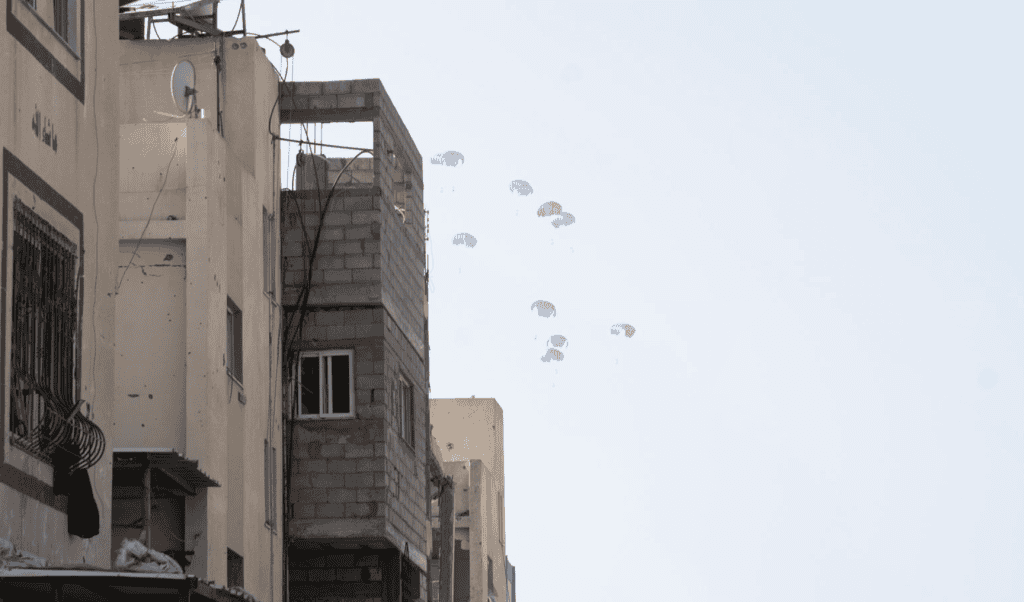
Israel and several partner countries are increasingly looking to airdrops as a method to deliver aid to civilians in Gaza. Airdrops have been used since the beginning of the war but increased in frequency during the last week of February. There are an estimated several hundred thousand Gazans in northern Gaza with another several hundred thousand in southern Gaza near the beach in a humanitarian zone called Mawasi. These areas are farther away from Rafah where most humanitarian aid is being routed by trucks and are prime targets for countries that have the ability to drop aid into Gaza.
Although it has been used in the past including coordination throughout February, the Israeli Defense Forces highlighted the new airdrop initiative on February 28. “In cooperation between Israel, the United Arab Emirates, Jordan, Egypt, France and the USA: a supply of food and medical equipment that was transferred to the residents of the southern Gaza Strip and the Jordanian field hospital was airdropped,” the IDF said. The increased airdrops follow the February 29 attempt to deliver aid in northern Gaza using trucks that ended in a stampede, killing 100 people. There are now calls for an investigation into why they were killed.
The UAE, France and Jordan have been conducting various types of aid missions related to the war in Gaza since the conflict began in the wake of the Hamas attack on Israel on October 7, 2023. For instance, the UAE has airlifted Gazan patients from Al-Arish in Egypt to the UAE for treatment. Under an operation called Gallant Knight 3, the UAE also sent a ship to Al-Arish to act as a floating hospital. France sent its Dixmude helicopter carrier to Al-Arish early in the war to provide aid to Gazans. This is a key capability of the DIxmude, one of the key ships that France can deploy on missions like this to provide aid during a conflict. Canada and the US are also considering airdrops, according to reports.
The Kingdom of Jordan coordinated with Israel early in the war to conduct airdrops in Gaza. Jordan is well-placed to do this, given its proximity to Gaza and working relations with Israel. Its C-130s only have to fly a short distance, around 140 miles, south of Israel’s capital of Jerusalem to reach Gaza. This has become a prestige mission for the Jordanians. Jordan’s Princess Salma took part in the fifth airdrop in mid-December in which supplies were dropped to a Jordanian field hospital in Gaza. King Abdullah of Jordan took part in a February 27 airdrop in which six C-130s flew out of Amman to drop the aid into Gaza. The Jordanians announced announced on March 1 that they had carried out three more airdrops in northern Gaza.
In addition to the Jordanian C-130s have been aircraft from France and the UAE. In what the UK Ministry of Defense called a “Jordanian-led effort,” the UK sent 582 cargo parachutes to Jordan in a C-17 to assist Amman in its air drops.
The IDF noted on February 28 that coordination with France, Egypt, Jordan and the UAE had resulted in 160 aid packages being dropped on February 27, which included “food and medical equipment for the residents of the southern Gaza Strip and the Jordanian field hospital in Khan Yunis.” The IDF noted that the drop took place “in coordination with the International Cooperation Division of the Strategic Planning and Cooperation Directorate (J5), the Coordination and Liaison Administration to Gaza (CLA) of the COGAT Unit, the 98th Division and the Israel Air Force.”
Israel has also utilized airdrop capabilities to supply IDF forces in Gaza. Israeli C-130s from the 103rd ‘Elephants’ squadron at Nevatim airbase have dropped water to Israel’s 98th division in Khan Younis as well as thousands of leaflets over cities across Gaza to warn civilians of impending operations or to seek information on hostages held by Hamas.







